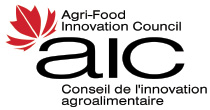
Theme 1: Dissemination Strategies and Participation Channels for Agricultural Research
Click on the workshop links below to expand the section and read presentation summaries as well as gain access to presentation and workshop files.
Workshop 1-A: Dissemination Strategies and Policies
 Drew Black, Director of Environment and Science Policy with the Canadian Federation of Agriculture (CFA) emphasized the importance of collaboration among stakeholders to build a national research policy framework that meets the challenges facing the Canadian agriculture sector, including research dissemination.
Drew Black, Director of Environment and Science Policy with the Canadian Federation of Agriculture (CFA) emphasized the importance of collaboration among stakeholders to build a national research policy framework that meets the challenges facing the Canadian agriculture sector, including research dissemination.
Black pointed out that research investment within the final stages of the research value chain – innovation and application – should maximize the benefits for primary producers and other stakeholders. He recommended launching a new funding stream focused on the knowledge translation and dissemination needs of researchers so that research results reach producers and processors.
Black argued that setting research priorities through a national agricultural research body would promote enhanced producer-researcher collaboration. This would ensure that producers are more aware of research being done, and would promote better engagement leading to increased uptake and support.
To move forward on policies that benefit research dissemination, greater collaboration among all key stakeholders involved in agricultural research must be achieved. The next agricultural research policy framework must be primarily centered on a more inclusive, coordinated, transparent and innovative policy development process.
Presentation: Policy Challenges on Dissemination – English
Présentation : Défis politiques en ce qui concerne la diffusion – Français
 Dr. Andreas Boecker, Associate Professor at the University of Guelph, spoke of the challenges in communicating information about modern agriculture with the public, specifically in biotechnology.
Dr. Andreas Boecker, Associate Professor at the University of Guelph, spoke of the challenges in communicating information about modern agriculture with the public, specifically in biotechnology.
Today’s consumers have become more interested in and critical of the foods they eat and the manner in which that food is produced. In many cases, consumers have been pushed to rely on untrustworthy sources of information, leading to misconceptions or false assumptions regarding biotechnology products.
To tackle these issues, Dr. Boecker highlighted the need to increase consumer engagement by bringing forward innovative communication strategies based on shared values, compassion and empathy. Value-based communication strategies represent a significant opportunity to build greater trust in agricultural research and greater acceptance of agricultural innovations.
Presentation: Communicating with the Public about Modern Agriculture, Biotechnology in particular – English
Présentation : S’entretenir avec le public sur l’agriculture moderne et la biotechnologie en particulier – Français
 Finally, a video-presentation on best practices for communicating agricultural research by Tracy Herbert, Beef Extension Coordinator at the Beef Cattle Research Council, explained how to catalyze wider adoption of agricultural innovation by targeting key individuals. She mentioned that the success of any innovation is heavily dependent on the involvement of “early-adopters” of innovations.
Finally, a video-presentation on best practices for communicating agricultural research by Tracy Herbert, Beef Extension Coordinator at the Beef Cattle Research Council, explained how to catalyze wider adoption of agricultural innovation by targeting key individuals. She mentioned that the success of any innovation is heavily dependent on the involvement of “early-adopters” of innovations.
Herbert pointed out that the key to adoption is that end-users must perceive innovations as relevant to their needs. Promoting wider adoption by emphasizing emotions and behaviours rather than highlighting technical features should constitute the guiding principle for communicating new research with potential end-users. Although knowledge dissemination has three key elements (content, presentation and delivery of communication products), the most important element is to “make research memorable”.
Herbert also recommended including end-users and extension specialists in the R&D process to gather valuable information needed for more effective and rapid adoption. Interactive resources and regular follow-up are only a few examples of communication practices to engage end-users in dissemination processes.
Finally, Herbert highlighted some best practices to involve researchers in the dissemination process such as encouraging and enabling them to actively participate in extension programs, offering public communication training to scientists through mentorships, and designing more practical research and extension programs.
Presentation: Best Practices for Communicating Agriculture Research – English
Présentation : Pratiques exemplaires de diffusion des résultats de la recherche agricole – Français
Workshop Resources:
Workshop Discussion Questions – English
Questions de discussion de l’atelier – Français
Workshop Handout – Disseminating Research – English
Document Ressource – Diffusion de la recherche – Français
Workshop 1-B: Bridging the Gap Between Research and the Public
 Mary Ann Binnie, Manager of Nutrition and Food Industry Relations at the Canadian Pork Council highlighted the importance of creating frameworks that use societal value, food security and sustainability goals as decision-making criteria in the sector.
Mary Ann Binnie, Manager of Nutrition and Food Industry Relations at the Canadian Pork Council highlighted the importance of creating frameworks that use societal value, food security and sustainability goals as decision-making criteria in the sector.
She emphasized the importance that the industry understands and addresses the gap between consumers and primary agriculture. With an increased pressure on the agri-food sector to explain its social licence, the ability to communicate often complex information is paramount.
Social responsibility programs play an important role in building trust in the sector. These programs help industry to communicate to the public and address the growing expectations of consumers, retailers and policymakers in areas that measure economic, environmental, social, and governance performance.
The critical aspect of these programs is communication. Transparency is a fundamental condition for social responsibility regardless whether reported information to the public is widely accepted or previously known.
Binnie concluded by pointing out that sound environmental and social practices are becoming a prerequisite for market access. Consumers have growing expectations of the agri-food industry and are looking for products that meet high and credible standards attesting to sustainable production.
Presentation: Bridging the Gap Between Research and the Public – English
Présentation : Combler le fossé qui sépare la recherche et le public – Français
 Award winning-author and science writer, Gabrielle Bauer, provided tips and guidelines to effectively communicate scientific research to the public. Paramount was the ability to emphasize the direct relevance of research products to consumers using plain language and applying storytelling techniques. Bauer mentioned the need to write in lively language by providing vivid descriptions, analogies and active voice sentences.
Award winning-author and science writer, Gabrielle Bauer, provided tips and guidelines to effectively communicate scientific research to the public. Paramount was the ability to emphasize the direct relevance of research products to consumers using plain language and applying storytelling techniques. Bauer mentioned the need to write in lively language by providing vivid descriptions, analogies and active voice sentences.
One of the most common pitfalls in science writing is the tendency to overcomplicate inherently complex material by focusing on technical details and the specifics of research findings. Writing accurately does not necessarily mean writing dryly. Researchers need to focus on catching the reader’s attention by emphasizing the benefits for consumers and focusing on the solutions the research offers.
Participants then participated in a series of interactive, and skill-building exercises to describe research using a logical flow with a high-impact lead addressing the “why” (current problem), keeping technical descriptions brief and easily understandable, and a high-impact conclusion linking it back to the issue and describing the wider implications of the research.
Presentation: Writing about Agriscience… so people will take notice – English
Présentation : Écrire sur l’agroscience… de sorte qu’on la remarque – Français
Workshop Resources:
Workshop Discussion Questions – English
Questions de discussion de l’atelier – Français
Workshop Handout – Tip Sheet – English
Document Ressource – Fiche-conseil – Français
Workshop Handout – Exercise – English
Document Ressource – Exercice – Français
